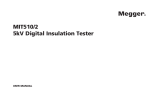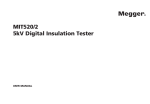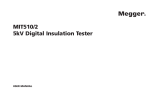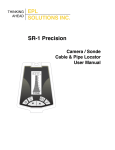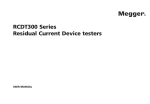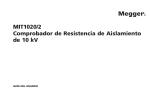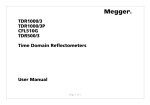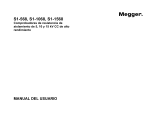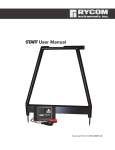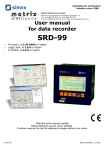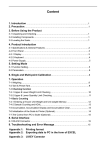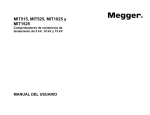Download L1072, L1073 & L1073-10
Transcript
AVTML1072/73 Rev 1 June 2012 User Guide L1072, L1073 & L1073-10 Megger Portable Locators Read this entire manual before operating. M Valley Forge Corporate Center 2621 Van Buren Avenue Norristown, PA 19403-2329 U.S.A. 610-676-8500 www.megger.com L1072, L1073 & L1073-10 Megger Portable Locators Copyright© 2012 by Megger. All rights reserved. The information presented in this manual is believed to be adequate for the intended use of the product. The products described herein should not be used for purposes other than as specified herein. Specifications are subject to change without notice. WARRANTY Products supplied by Megger are warranted against defects in material and workmanship for a period of one year following shipment. Our liability is specifically limited to replacing or repairing, at our option, defective equipment. Equipment returned for repair must be shipped prepaid and insured. Contact your local MEGGER representative for instructions and a return authorization (RA) number. Please indicate all pertinent information, including problem symptoms. Also specify the serial number and the catalog number of the unit. This warranty does not include batteries, lamps or other expendable items, where the original manufacturer’s warranty shall apply. We make no other warranty. The warranty is void in the event of abuse (failure to follow recommended operating procedures) or failure by the customer to perform specific maintenance as indicated in this manual. Australia Megger Pty Limited Unit 1, 11-21 Underwood Road Homebush NSW 2140 T: +61 (0)2 9397 5900 F:+61 (0)2 9397 5911 Germany Megger GmbH Obere Zeil 2 61440 Oberursel Deutschland Local Megger Offices Canada 110 Milner Avenue Unit 1 Scarborough Ontario M1S 3R2 Canada T: 1 416 298 6770 F: 416 298 0848 France 23 rue Eugène Henaff ZA du Buisson de la Couldre 78190 TRAPPES T: 01 30 16 08 90 F: 01 34 61 23 77 India Megger (India) Pvt Limited 501 Crystal Paradise Mall Off. Veera Desai Road Andheri (W) Mumbai 400053 T: +91 22 26740468 F: +91 22 26740465 Kingdom of Bahrain P.O. Box 15777 Office 81, Building 298 Road 3306, Block 333 Manama Kingdom of Bahrain. T: +973 177 40 620 F: + 973 177 20 975 [email protected] Kingdom of Saudi Arabia PO Box 1168 Khobar 31952 South Africa PO Box 22300 Glen Ashley 4022 Durban South Africa T: +966 3889 4407 F: +966 3889 4077 [email protected] T: +27 (031) 5646578 F:+27 (031) 5637990 Sweden Megger Sweden AB Eldarvägen 4 Box 2970 SE-187 29 TÄBY SWEDEN T: +46 8 510 195 00 F: +46 8 510 195 95 Switzerland Megger Schweiz AG Ob. Haselweg 630 5727 Oberkulm Aargau T: +41 62 768 20 30 F: +41 62 768 20 33 United Kingdom (Dover) Megger Limited Archcliffe Road Dover CT17 9EN United States (Dallas) 4271 Bronze Way, Dallas, Texas 75237-1019 USA United States (Valley Forge) Valley Forge Corporate Centre 2621 Van Buren Avenue Norristown, PA 19403 USA T: 610 676 8500 F: 610-676-8610 T: 06171-92987-0 F: 06171-92987-19 T: 1-800-723-2861 F: 1-214-331-7399 T: 01304 502101 F: 01304 207342 United States (College Station) 4064 State Highway 6 South College Station, TX 77845 USA T: 979-690-7925 F: 979-690-0276 Safety Voltages of greater than 50 V applied across dry unbroken human skin are capable of producing heart fibrillation if they produce electric currents in body tissues which happen to pass through the chest area.[citation needed] The electrocution danger is mostly determined by the low conductivity of dry human skin. If skin is wet, or if there are wounds, or if the voltage is applied to electrodes which penetrate the skin, then even voltage sources below 40 V can be lethal if contacted. Additionally research has shown that where the skin has been compromised, very small voltage of up to 3V can kill. Accidental contact with high voltage supplying sufficient energy will usually result in severe injury or death. This can occur as a person's body provides a path for current flow causing tissue damage and heart failure. Other injuries can include burns from the arc generated by the accidental contact. These can be especially dangerous if the victim's airways are affected. Injuries may also be suffered as a result of the physical forces exerted as people may fall from height or be thrown a considerable distance. Low-energy exposure to high voltage may be harmless, such as the spark produced in a dry climate when touching a doorknob after walking across a carpeted floor. Table of Contents 1 SPECIFICATIONS ............................................................................................................................... 1 Receiver (L1072, 1073 & L1073-10) ........................................................................................... 1 Transmitter (L1072, L1073 & L1073-10 .................................................................................... 2 Battery Charger (L1073) ............................................................................................................... 3 Battery Charger (L1073-10) ......................................................................................................... 4 Supplied Components .................................................................................................................. 5 Optional Accessories (not supplied as standard) ...................................................................... 5 . 2 SAFETY .................................................................................................................................................. 7 Precautions ..................................................................................................................................... 7 Warning and Caution Notices ..................................................................................................... 8 3 GETTING TO KNOW YOUR L1072, L1073 & L1073-10.......................................................... 9 Receiver ........................................................................................................................................... 9 Controls ............................................................................................................................. 9 Receiver .........................................................................................................................................11 Display .............................................................................................................................11 Transmitter ...................................................................................................................................12 Controls ...........................................................................................................................12 Transmitter ...................................................................................................................................13 Display .............................................................................................................................13 4 PREPARING FOR USE .................................................................................................................... 15 General ..........................................................................................................................................15 Preparing the Receiver and Transmitter ..................................................................................15 TX Rechargeable Battery (L1073 & L1073-10) ......................................................................15 Recharging the Battery/External Power Pack ........................................................................16 5 OPERATION....................................................................................................................................... 17 Transmitter ...................................................................................................................................17 Direct Connection .........................................................................................................17 Coupler & Flexicoupler Connection ...........................................................................18 Inductive Connection ....................................................................................................19 Blind Search ....................................................................................................................20 Selecting the Tracing Signal ..........................................................................................20 Receiver .................................................................................... Error! Bookmark not defined. Locating the Cable or Pipe ...................................... Error! Bookmark not defined. Selecting the Locating Mode (Peak or Null) ......... Error! Bookmark not defined. Peak Mode Locating ................................................. Error! Bookmark not defined. Null Mode Locating ......................................................................................................22 Absolute Signal Strength ...............................................................................................23 Gain Change Indication ................................................................................................23 Passive 50/60 Hz Locating ..........................................................................................24 Passive Radio Frequency Locating ..............................................................................24 AVTML1072/73 Rev 1 June 2012 i M Push Button Depth ....................................................................................................... 24 Current Measurement ................................................................................................................. 25 Depth Measurement 45º Angle Method .................................................................... 26 Tilted Magnetic Field Identification............................................................................ 26 6 FAULT LOCATING WITH THE L1072/L1073 ......................................................................... 27 Introduction ................................................................................................................................. 27 Signal Return through an Insulated Fault ................................................................................ 27 Setting the Transmitter to Fault Mode..................................................................................... 28 Setting the Receiver to Fault Mode .......................................................................................... 28 Ground Return Probe ................................................................................................................ 28 Ground Return Probe Insertion ............................................................................................... 29 Ground Return Probe Fault Locating ...................................................................................... 29 7 SERVICE .............................................................................................................................................. 31 Maintenance ................................................................................................................................. 31 Repair ............................................................................................................................................ 31 AVTML1072/73 Rev 1 June 2012 ii M UPON RECEIPT OF YOUR DELIVERY Prior to operation, check for loosened hardware or damage incurred during transit. If these conditions are found, a safety hazard is likely, DO NOT attempt to operate equipment. Please contact Megger as soon as possible. Please check your delivery against: a) your order b) our advice note c) the item delivered, and d) the parts list any shortages must be reported immediately. AVTML1072/73 Rev 1 June 2012 iii M STANDARD MANUAL CONVENTIONS This manual uses the following conventions: Bold indicates emphasis or a heading. NOTE: is used to set off important information from the rest of the text. A WARNING symbol alerts you to a hazard that may result in equipment damage, personal injury, or death. Carefully read the instructions provided and follow all safety precautions. A CAUTION symbol alerts you that the system may not operate as expected if instructions are not followed. AVTML1072/73 Rev 1 June 2012 iv 1 SPECIFICATIONS Receiver (L1072, 1073 & L1073-10) Operating Frequency Active: 82kHz, 33kHz, 8kHz, 815Hz Passive: 50/60Hz Mode Null Peak Audio Indication Variable pitch response on all frequencies Depth Measurement Automatic Push-button digital depth readout to 15ft (4.6m) Manual Triangulation Current Measurement LCD bar graph displays relative current/signal strength. Readout between 0 – 999 Gain Control Up/Down button for automatic centring and manual control. Dynamic Range 126dB Battery Life Continuous 40 hrs Intermittent 82 hrs (10min auto shut-off) Battery Type "C" type Alkaline batteries (qty 6 required) Operating Temperature -4°F to 133°F (-20°C to +55°C) Weight 3lbs (1.36kgs) Dimensions 30.3 x 3.75 x 9.4in (L x W x H) 76.9 x 9.3 x 23.8cm (L x W x H) AVTML1072/73 Rev 1 June 2012 1 M Transmitter (L1072, L1073 & L1073-10 Operating Frequency Simultaneous Output 82kHz, 33kHz, 8kHz, 815Hz 815Hz & 83kHz L1072/L1073 L1073-10 Low High Low High 815Hz 0.2W 5W 0.6W 8W 8kHz 0.2W 5W 0.6W 10W 33kHz 0.2W 5W 0.6W 10W 82kHz 0.2W 5W 0.2W 1.0W 815HZ & 83kHz .06W 0.67W 0.06W .067W Load Matching Automatic in the range from 5Ω to 20,000Ω Connection Direct : TX Inductive Inductive Coupling (requires optional coupler) Battery Life L1072 L1073/73-10 Continuous 8-15hrs Greater than 30hrs Intermittent 40-60hrs 60-80hrs (load, frequency & power setting dependent) Battery Type L1072 "D" type Alkaline batteries (qty 8) L1073 Rechargeable 12V 7Ah maintenance free sealed lead acid battery L1073-10 Rechargeable (24V) 2 x 12V 5Ah sealed lead acid battery Operating Temperature -4°F to 133°F (-20°C to +55°C) Weight L1072 8lbs (3.6kgs) L1073 12.5lbs (5kgs) L1073-10 12.5lbs (5kgs) Dimensions 16 x 6.32 x 6in (L x W x H) 41 x 16 x 15cm (L x W x H) AVTML1072/73 Rev 1 June 2012 2 SPECIFICATIONS Battery Charger L1073 Input 90-264v AC 47-63Hz Output 12V dc @ 14.7W Charge Current 1.0A ± 5-7% Charge Voltage 14.7V Standby Voltage: 14.7V Charge Termination 250mA ±20% Output Connection 2.5 x 5.5 x 9.5mm barrel plug, center positive Input Connection 2-pin IEC320-C7 (US, EU & AU input plugs included) Dimensions 4.06 x 1.81 x 1.54in. (L x W x D) 103 x 46 x 39mm. (L x W x D) Observe the following precautions when using the dc battery charger. G CAUTION Not recommended for batteries with less than 3.0Ah capacity. Do not use on damaged or shorted batteries. Allow for air circulation around charger case. Do not cover. Do not use if circuit is exposed to moisture. Disconnect immediately if batteries get hot. AVTML1072/73 Rev 1 June 2012 3 M Battery Charger L1073-10 Input 90-264v AC 47-63Hz Output 24V dc @ 14.7W Charge Current 1.0A ±5-7% Charge Voltage 29.4V Standby Voltage: 27.4V Charge Termination 250mA ±20% Output Connection 2.5 x 5.5 x 9.5mm barrel plug, center positive Input Connection 2-pin IEC320-C7 (US, EU & AU input plugs included) Dimensions 4.06 x 1.81 x 1.54in. (L x W x D) 103 x 46 x 39mm. (L x W x D) Observe the following precautions when using the dc battery charger. G CAUTION Not recommended for batteries with less than 1.5Ah capacity. Do not use on damaged or shorted batteries. Allow for air circulation around charger case. Do not cover. Do not use if circuit is exposed to moisture. Disconnect immediately if batteries get hot. AVTML1072/73 Rev 1 June 2012 4 SPECIFICATIONS Supplied Components L1072 / L1073 / L1073-10 4-active and 2-passive frequency Receiver 6 x 1.5 “C” type Batteries L1072 5W Transmitter 8 x 1.5V “D” type Batteries L1073 5W Transmitter (rechargeable) 12V 7Ah sealed lead acid battery d.c. Charger L1073-10 10W Transmitter (rechargeable) 2V 7Ah sealed lead acid battery d.c. Charger Red/Black lead (Large Clamp) 20ft (6.1m) direct Connection lead with clamps Ground/Earth Rod For near end independent grounding/earthing User Manual AVTML1072/L1073 Optional Accessories (not supplied as standard) Flexible Coupler (Inductive) 651076 4inch Coupler (Inductive) 651079 Folding Ground Return Probe 651075 651078 d.c. charger (automotive) AVTML1072/73 Rev 1 June 2012 5 M M AVTML1072/73 Rev 1 June 2012 6 2 Safety Precautions These guidelines do not take precedence over the operator Companies own guidelines, SAFETY procedures or policies, which must take precedence. The L1072, L1073 and L1073-10 Portable Locators and the recommended operating procedures have been designed with careful attention to safety; however, it is not possible to eliminate all hazards from electrical test equipment or to foresee every possible hazard that may occur. It is therefore essential that the user, in addition to following the safety rules in this manual, also carefully consider all safety aspects of the test before proceeding. Safety is the responsibility of the user. F WARNING! Do NOT connect to live or energized power cable. Use suitable barriers, barricades, and warnings to keep people not actually engaged in the test at a safe distance. Make sure that no one can make contact with energized parts of the test equipment and the specimen under test. Treat all terminals of power equipment as a potential electric shock hazard. There is always the possibility of voltages being induced at these terminals because of proximity to energized high-voltage lines or equipment. Always turn the transmitter power off before touching any terminals. Always disconnect test leads from the cable under test before attempting to disconnect them from the portable locator. Never connect the test leads to a cable that does not have a safety ground strap in place. Never disconnect the test leads from a cable that does not have a safety ground strap in place. The safety ground connection must be the first made and the last removed. Any interruption of the grounding connection can create an electric shock hazard. Observe all safety warnings marked on the equipment. These warnings identify areas of immediate hazard which could result in personal injury or loss of life. AVTML1072/73 Rev 1 June 2012 7 M Do not operate the equipment with protective covers removed. Operation without the protective covers presents an electric shock hazard. Use all practical safety precautions to prevent contact with energized parts of the equipment and related circuits. Use the recommended grounding and connection procedures. Make sure that the equipment is grounded properly. Any interruption of the grounding connection can create an electric shock hazard. Refer to IEEE 510-1983 "IEEE Recommended Practices for Safety in High-Voltage and High-Power Testing" for additional information. Do not use the portable locator or its accessories with any device or for any purpose other than as specifically described in this manual. Misuse of this equipment can be extremely dangerous. Never connect the portable locator to energized equipment. Do not use in an explosive atmosphere. The L1071 Portable Locator uses rechargeable batteries. Replace only with sealed leadacid batteries as specified in Section 3, Specifications. Danger of explosion can result if the wrong batteries are used. If the portable locator is operated in accordance with the safety precautions described, and if all grounds are correctly made, rubber gloves are not necessary. As a routine safety procedure, however, some users require that rubber gloves be worn, not only when making connections to the high-voltage terminals but also when manipulating controls. Megger considers this an excellent safety practice. Warning and Caution Notices Warning and caution notices are used throughout this manual where applicable. These notices appear in the format shown below and are defined as follows: F G WARNING! Warning, as used in this manual, is defined as a condition or practice which could result in personal injury or loss of life. CAUTION Caution, as used in this manual, is defined as a condition or practice which could result in damage to or destruction of the equipment or apparatus under test. AVTML1072/73 Rev 1 June 2012 8 3 GETTING TO KNOW YOUR L1072, L1073 & L1073-10 Receiver Controls 1. Depth or Current Button Depth function will first momentarily display the depth mode (Line [LIN] or Sonde [SON]) and then display depth measurment at the top of the LCD. To change the depth measurment from Imperial to Metric, hold the depth key for ten (10) seconds. Secondary function is accessed by depressing and holding Shift Key (6) whilst selecting secondary key function. Current function measures the relative amount of transmitted current is displayed at the bottom of the LCD. 2. ON/OFF Turns the unit on or off. Previous settings will be loaded when unit is turned on. Automatic shut-down after 10minutes of no use 3. Frequency Button Toggles through available active and passive frequencies. 4. Gain Button (Down) Adjusts the gain down. If the signal strength shows as “---“ on the display, pressing the gain will automatically adjust to 85% on the scale display. AVTML1072/73 Rev 1 June 2012 9 M 5. Mode or Volume Button Mode, allows selection of the operation mode of the receiver. i.e. Peak, Pinpoint Peak, Null, (ACC when an accessory is plugged in) and SONDE location modes. Secondary function is accessed by depressing and holding Shift Key (6) whilst selecting secondary key function. Volume toggles volume through High, Medium, Low and OFF. 6. Shift Key Used to selected the secondary function of any key. The secondary function is accessed by depressing and holding Shift Key (6) at the same time as depressing button of desired function. 7. Gain Button (Up) Adjusts the gain down. If the signal strength shows as “---“ on the display, pressing the gain will automatically adjust to 85% on the scale display. AVTML1072/73 Rev 1 June 2012 10 GETTING TO KNOW YOUR L1072, L1073 & L1073-10 Receiver Display 8. Signal Strength or Depth Displays the absolute signal strength or depth 9. Relative Signal Strength Displays the relative strength of the signal being received. Single bar shows gain settings. 10. Operation Mode Displays the selected mode of operation i.e. i.e. Peak, Pinpoint Peak, Null, (ACC when an accessory is plugged in) and SONDE location modes 11. Selected Frequency Displays the selected Frequency AVTML1072/73 Rev 1 June 2012 11 M Transmitter Controls 12. TX Output Jack The Red/Black lead, Couple and Flexicoupler connect here. 13. Output Level Control The output level control adjusts the output power from the transmitter. There are five levels from low to high. 14. Frequency Selector Used to select the required transmitter frequency: 82kHz; 815Hz; 8kHz; 33Khz 15. TX Signal Information Selector The transmitter can display the relative resistance, current and voltage of the transmitted signal. The resistance is based on the feedback from the selected frequency is not an actual impedance meter. These parameters are selected buy toggling the Signal Informaion button 16. Power ON / Off Turns the Transmitter ON or Off AVTML1072/73 Rev 1 June 2012 12 GETTING TO KNOW YOUR L1072, L1073 & L1073-10 Transmitter Display 17. Load Rate Indicator The load rate indicator symbol fashes to indicate the output circuit impendance/ 4-blinks per second: Indicates the TX is near a “nearly short circuit” 1-blink per 3-seconds: Indicated a “nearly open circuit” Note: Holding down the outuput signal level button for 2-seconds will mute the audio load rate indicator. 18. Relative Resistance, Volt, Current Displays the relative resistance, voltage and current of the output signal. These parameters are selected buy toggling the Signal Informaion button 19. Battery Condition Indicates the condition of the transmitter batteries. AVTML1072/73 Rev 1 June 2012 13 M M AVTML1072/73 Rev 1 June 2012 14 4 PREPARING FOR USE General Check the equipment received against the packing list to ensure that all materials are present. Examine the instrument for damage. If damage is discovered do not attempt to use the instrument, prepare a detailed description of the damage and notify your supplier. The instrument has been thoroughly tested and inspected to meet rigid specifications before being shipped It is ready for use when set up as indicated in the user manual. Preparing the Receiver and Transmitter Receiver: Locate the battery compartment on the back of the “head” of the receiver. Open the compartment using a Phillips screwdriver and install the six 1.5V “C” type batteries as indicated on the battery holder. Re-instate Install the battery cover and tighten the retaining screws. Transmitter: Locate the battery compartment on the bottom of the transmitter. Remove the screws from the battery compartment door. Install the batteries as marked on the battery holder. Re-instate the battery cover and tighten the retaining screws. L1073 & L1073-10 Only: Charge the transmitter batteries for at least 5-hours before using. TX Rechargeable Battery (L1073 & L1073-10) If your transmitter has rechargeable batteries, the battery cover will extend past the main transmitter housing shell approximately 1/2 in. (1.27 cm). The recharger jack is situated near the carrying handle on the transmitter housing. To replace the sealed, rechargeable 12 V, 7Ah lead-acid battery, remove the back cover and four nuts on each side of the battery bracket. Remove the battery, then remove the red wire and the black wire from the battery terminals by pulling off the spade connectors. An automatic shutdown circuit protects the lead-acid battery from discharging below the safe level of 8.2 V. Reset the automatic shutdown circuit by turning the POWER OUTPUT switch OFF. When the battery voltage is discharged down to 10.5 V, the LOW BAT icon on the LCD is activated. From the time the LOW BAT icon is activated, you will have between 15 and 30 min of operating before automatic shutdown occurs. Also, when the LOW BAT icon is activated, the transmitter output signal will cycle every 20 sec. AVTML1072/73 Rev 1 June 2012 15 M Recharging the Battery/External Power Pack G CAUTION Set the transmitter POWER OUTPUT switch to OFF before you begin recharging. Using the ac charger: A fully discharged battery can be fully charged in less than 24hr using the ac charger. A partially discharged battery requires less recharging time. Overcharging shortens battery life. Using the dc charger: A fully discharged battery can be fully charged in less than 5hr using the 12V dc charger. Typically, 10 min of charge will give you 20 min of usage. Although it is possible to power the transmitter with the automotive charger, the charger will not supply enough energy to charge the battery at the same time. AVTML1072/73 Rev 1 June 2012 16 5 OPERATION Transmitter F WARNING DO NOT CONNECT TO LIVE OR ENERGISED POWER CABLES Direct Connection Direct Connection is the most reliable method of signal application. This method is relatively free of interference. The greatest amount of signal strength can be achieved by this method. Low, mid, and high frequency may be used. The far end of the utility must be grounded. Connect the Red Test Cord to an existing ground point or an exposed metallic section of the utility . Place the Ground Rod approximately 10 feet from this point, at an angle of 90º to the buried cable or pipe. Push the Ground Rod into the ground 8 to 10 inches. Connect the Black Test Cord to the Ground Rod. Plug the Red/Black Test Cord into the TX OUTPUT JACK. Press the FREQUENCY Button for 815 Hz, 8 kHz, 33 kHz or 82 kHz. The Power Output Indicator and the Frequency light of the chosen frequency will light up. AVTML1072/73 Rev 1 June 2012 17 M Coupler & Flexicoupler Connection The optional Flexicoupler and Hard Coupler are very easy to use, and services do not have to be interrupted. The operation range is shorter than for Direct Connection methods. The tracing signal can be affected by neighboring cables and pipes. The Red/Black Test Cord or the Ground Rod are not needed for this method. Successful coupler operation requires an insulated conductor that is grounded on both near and far ends. Loop the Flexicoupler around the cable and connect the two ends, or clamp the Hard Coupler around the cable. It is important to connect the coupler around the cable needing to be traced. Connect the coupler around the wire closer to the outgoing cable not near the system ground. The result will be a stronger signal. By connecting near the grounding, the range will also be shorter, and difficulty may arise determining one cable from another. Plug the Coupler Test Cord into the TX OUTPUT JACK. Always use the 82 kHz FREQUENCY on the Receiver and the Transmitter. AVTML1072/73 Rev 1 June 2012 18 OPERATION Inductive Connection This method is convenient to use, and services are not interrupted. No test cords or connections are needed. The cable or pipe must have good insulation or non-conductive coating, or the operating range will be short. Turn the Transmitter ON. Press the 82 kHz button. Place Transmitter on its side as close as possible to the path of the cable or pipe. Align the AROWS on the SIDE OF THE TRANSMITTER in line with the cable or pipe. First, locate the broad Transmitter Null, then move toward the expected cable path while looking for the signal carried by the cable. Start tracing the path with the Receiver 25 feet from the Transmitter. Search in the 90º zone as shown above. Locate the cable or pipe, and follow the path. If the signal becomes weak, move the Transmitter to a point 25 feet behind the last strong signal, and continue searching. AVTML1072/73 Rev 1 June 2012 19 M Blind Search The Blind Search locating techniques is used if the operator is not aware if a buried utility exists. Two people are needed for this technique. The Transmitter and the Receiver are Held 25 feet away from each other. Each operator walks at the same speed keeping a distance of 25 feet from each other. When the receiver gives an audio response, then a buried utility is present between the Receiver and the Transmitter. Selecting the Tracing Signal The choice of 815 Hz, 8 kHz, 33kHz or 82 kHz Frequency is dependent on the conditions of the locate. The 815 Hz, 8 kHz, 33kHz and 82 kHz signals each have their advantages. It is recommended to begin by using the 815 Hz signal, and continue as long as you are confident in the results. If the signal is very weak try to adjust the connection or grounding. If there is no improvement in signal then try 8 kHz. Repeat adjustments of ground and connection point again until switching to 33 kHz and then 82 kHz. 815 Hz (lower frequency) signal is usually preferred to the 8 kHz (mid-range frequency) and 82 kHz (high frequency) signal, because it is much less susceptible to locating errors caused by nearby cables or pipes. The 815 Hz locating range is also much longer than the 82 kHz signal. The 815 Hz signal will not travel well through disconnected shield bonds or insulated pipe bushing. 8 kHz and 33kHz takes the best of both high and low frequency. This mid range frequency is not very susceptible to bleed off or coupling, but it can jump impedance on AVTML1072/73 Rev 1 June 2012 20 OPERATION the utility better than the 815 Hz. It is still best to use 815 Hz, but 8 kHz is one of the most common frequencies used to locate coaxial cable and telecom pairs. The 82 kHz (higher frequency) is sometimes better than the 815 Hz (lower frequency) for locating sharp corners in cables or pipes. The 82 kHz signal is also better for “jumping” disconnected shield bonds or grounds, or tracing signal may indicate one of these characteristics. The locating range is quite short for the 82 kHz signal so the Transmitter must be repositioned more often during the tracing operation. This frequency is also useful for applying a signal using the Flexicoupler or the Hard Coupler. Receiver Locating the Cable or Pipe Make sure the Transmitter is connected and in the ON position. Then move approximately 15 feet (4.5 meters) away from the Transmitter along the path. (Move about 25 feet (7.5 meters) for the Inductive search mode.) Hold the Receiver so that you can see the LCD bargraph and controls easily. Make sure the Receiver and the Transmitter FREQUENCY are both set for the same FREQUENCY, either 815 Hz (lower), 8 kHz, 33kHz or 82 kHz (higher). Or select the passive locating mode which do not require the transmitter. Selecting the Locating Mode (Peak or Null) Press the MODE button to select the desired Peak or Null locating method. Peak Mode Locating Keep the Receiver in a vertical position. Move the Receiver left to right across the path. When the Receiver is directly above the cable or pipe, rotate the Receiver for a maximum signal. As you move the Receiver away from the cable path, the meter reading (and audio frequency response) will drop off. If you rotate the Receiver while over the cable, a sharp NULL will identify the cable’s direction. It is aligned with the flat side of the Receiver. AVTML1072/73 Rev 1 June 2012 21 M Trace the path by walking away from the Transmitter at a moderate pace. Move the Receiver to the left and right while walking, following the PEAK indications. As you trace the path, the PEAK meter reading may slowly fade as you move away from the Transmitter. Press and release the GAIN buttons as needed to compensate for changes in level (higher or lower). One of the following may occur: a) junction where the signal splits and goes several directions. b) a break in the cable or shield. c) a change in the depth of the cable or pipe. d) an insulated pipe fitting. e) a slack loop of cable. If you can no longer trace the path, even with the GAIN set to maximum, connect the Transmitter to the far end of the path and trace back to the point where you lost the signal. Mark the straight sections of the path every few feet. Mark sharp curves, loops, and cable bundles every few inches. Sharp changes in the path cause the Receiver PEAK and NULL indications to behave differently than when tracing a straight path. Practice on the path that you know has turns and laterals in it. This will help you to recognize the conditions within the field. Null Mode Locating Move the Receiver left to right across the cable path. When the Receiver is directly above the cable or pipe, a NULL (lowest meter reading and lowest audio tone) will occur. When moving the Receiver to left or right of the NULL point, the meter reading will rise to a maximum point (PEAK). The audio tone will also be at its highest pitch. When the Receiver is moved beyond the PEAK, the meter reading will begin to fade. Trace the path by walking away from the Transmitter at a moderate pace. Move the Receiver to the left and right when walking, following the NULL indications. AVTML1072/73 Rev 1 June 2012 22 OPERATION As you trace the path, the PEAK meter reading may slowly fade as you move away from the Transmitter. Press and release the GAIN buttons as needed to compensate for changes in signal level. If the PEAK meter readings suddenly changes in level (higher or lower), one of the following may have occurred: a) a junction where the signal splits and goes several directions. b) a break in the cable or shield. c) a change in the depth of the cable or pipe. d) an insulated pipe fitting. e) a slack loop of cable. If you can no longer trace the path, even with the GAIN control set to maximum, connect the Transmitter to the far end of the path, and begin tracing the path back. Mark the straight section of the path every few feet. Mark sharp curves, loops, and cable bundles every few inches. Sharp changes in the path causes the Receiver PEAK and NULL indicators to behave differently than when tracing a straight path. Practice on the path that you know has turns and laterals in it. This will help in recognizing the conditions within the field. Absolute Signal Strength The L107X Receiver provides the operator with a direct measurement of the Receiver’s signal strength. The measurement is displayed with three numerical digits (ex: 485) located at the top of the LCD display. The measurement range is from 0 to 999 indicating a very week signal (0) to a very strong signal (999). Absolute Signal Strength is independent of the GAIN setting or meter reading. It gives the operator information about the actual amount of signal being radiated from the conductor and received by the Receiver. Measuring Absolute Signal Strength at any time is done by reading the number at the top of the LCD display. The Absolute Signal Strength will not be displayed if the meter reading is too high or too low. Adjust the GAIN to move the meter reading to mid-scale. The numerical display will change from ‘---’ to a valid measurement. Absolute Signal Strength measurements are more sensitive to signal changes than the meter display. PEAKS and NULLS can be more precisely pin-pointed. This measurement can also be used to monitor signal loss as the conductor is being traced. Gain Change Indication The GAIN up and down buttons are used to increase and decrease the gain in small amounts. If the meter reading is very low, pressing the GAIN up button will centre the meter reading to mid-scale. Likewise, if the meter reading is very high, pressing the GAIN down button will centre the meter reading to mid-scale. AVTML1072/73 Rev 1 June 2012 23 M Passive 50/60 Hz Locating The L107X Receiver is capable of locating power utility frequencies. This MODE is useful for locating underground primary and secondary power utilities. In certain circumstances, this MODE will also locate water pipes, sewer lines, cable television, and telephone. The reason is that common electrical grounds are sometimes found among these various utilities. Select the 50/60~ (Hz) frequency on the Receiver. Select PEAK mode. Locate the conductor using the PEAK mode. This method is useful because of its speed and convenience. Start at a known reference point and keep in mind that other conductors in the area may produce this same locating signal. The Transmitter is not required to locate in this mode. Passive Radio Frequency Locating The L107X Receiver is capable of passively locating metallic utilities where radio frequencies have coupled to the utility. This mode is useful for sweeping a green area for utilities. In certain circumstances, this mode will locate water pipes, cable television, gas lines and telephone. This locating option does not always detect buried utilities even when radio frequencies are present. This method is useful because of its speed and convenience. Start at a known reference point and keep in mind that other conductors in the area may produce this same locating signal. The Transmitter is not required to locate in this mode. Push Button Depth The only way to be sure of the depth of a utility is to exposes the utility. At any given time, the depth readout may be inaccurate. The L107X Receiver can measure depth with the push of a button. The depth is displayed at the top of the LCD display in meters and centimeters. Push button depth is useful in quickly determining the depth of the conductor during path locating. Begin this measurement by locating the path of the cable or pipe. Move to the location where you want to measure the depth. Stay at least 15 feet (4.6 meters) away from the Transmitter. Pin-point this location as accurately as possible (see Peak Mode Locating page 19, Null Mode Locating page 20 and Absolute Signal Strength page 21). Place the Receiver vertically over the conductor and rest the foot of the locator on the ground. While holding the Receiver vertical, press and release the DEPTH button. The Receiver will briefly indicate a measurement is being performed and then display the depth at the top of the LCD display. Caution must be exercised when using the push button depth feature, as tilted magnetic fields and adjacent conductors can significantly influence this measurement. The operator should periodically check for adjacent conductors and tilted magnetic fields AVTML1072/73 Rev 1 June 2012 24 OPERATION when taking push button depth readings. For information on identifying tilted magnetic fields, refer to Tilted Magnetic Field Identification and Depth Measurement 45º Method. Note: The L107X is designed to alert the operator of potential current and depth measurement errors. If the display reads ‘Err’ during a current and depth measurement, the Receiver has detected a condition that could produce inaccurate readings. Errors can exist when the conductor signal flow is too small. Check Transmitter hook up and far end access point for poor connections. This cause of error can be identified by a high GAIN setting (80 or greater on the bar graph display). The Receiver may also be detecting adjacent cables or is not directly over the target conductor. Verifying target conductor path precisely before measuring current again. If at any time the display reads ‘CAL’, contact your supplier. Current Measurement The L107X Receiver contains a feature that is very useful in identifying a desired cable in a field of various conductors and/or utilities. It is not unusual for the target conductor (the conductor connected to the transmitter) to induce a signal into nearby conductors in a crowded field. In these instances, the radiated signal on the conductors close to the surface of the earth, may be stronger than the Transmitter signal on the target conductor buried deep in the ground. The operator will find two or more paths and must determine which is the target conductor. By using the current measurement feature of the L107X Receiver, the operator can determine the amount of 815 Hz, 8 kHz, 33kHz or 82 kHz current flowing on the conductors, regardless of the depth. The highest current flow indicates the target conductor. 1. Place the Receiver vertically over one of the conductor marks and rest the foot of the locator on the ground. 2. Hold the Receiver vertical, press and release the Shift Button & Depth button simultaneously. When the meter changes from a “thermometer” type display to a “bar” type display, hold the Receiver still until the measurement stabilizes. The blinking bar indicates the signal level on the cable (adjusted for depth). 3. Next, move to the second cable and repeat the measurement. The blinking bar will show the signal level on the conductor. In addition, the previous reading is shown as a solid bar. The higher of these two readings will show which conductor is carrying the greatest locating signal. AVTML1072/73 Rev 1 June 2012 25 M Depth Measurement 45º Angle Method Move to the location you want to measure depth. Stay at least 15 feet away from the Transmitter. Move the Receiver left to right across the path until the cable is located. Mark the path on the ground as precisely as possible using the Null Method. Place the Receiver on the ground with the LCD meter facing up. Position the unit so that the BUBBLE LEVEL on top of the meter is centered (45º). Pull the Receiver away from the cable path (at 90º to the cable path) keeping the BUBBLE LEVEL centered. When the receiver indicates a NULL reading, mark the location of the receiver’s foot. The distance between the Receiver and the cable path is the depth of the pipe or cable. A false depth reading may be caused by nearby buried metallic objects, such as a second cable, pipe, sewer, fence or railroad track. Confirm the depth measurement by repeating the above steps on the opposite side of the pipe or cable. A variance greater than 5 inches in depth measurement may indicate the presence of additional buried cables, pipes or other objects. Tilted Magnetic Field Identification When adjacent cables or pipes are present, they will sometimes create locating errors. Some of the Transmitter signal is picked up by the adjacent conductors and is redirected so that it combines with the original signal. The result is a Tilted Magnetic Field. This is often the reason that numeric depth readouts are sometimes created in error. The operator can verify the accuracy of path locate by performing the 45º Angle Method locate on both sides of the cable path. If the right and left side depth readings agree to within 5 inches, the path locate is accurate. If the two depth readings do not agree, then dig with care. A closer locate would be halfway between the two outside depth locate marks. This is an important technique that should be used to ensure the most accurate location possible. AVTML1072/73 Rev 1 June 2012 26 6 Fault Locating with the L1072/L1073 Introduction Fault locating determines the position of an insulated break on an underground conductor. In the case of an insulation fault, some of the signal will return to the TRANSMITTER attached to the GROUND ROD through a break in the insulation. Figure 16: Signal Return through an Insulation Fault to Earth Signal Return through an Insulated Fault It is generally a good idea to locate the conductor path before attempting to fault locate. If, during the path locate, an unusual amount of signal loss occurs, a part of the signal has escaped to ground in the last several feet. Note: Signal would go to ground at a grounded splice point, which would act as a fault during the path and fault locate. Once the path is determined and there is a general area where a fault is expected, additional current can be forced to flow through the fault by disconnecting and isolating the far access point. If the current has no path to ground at the far access point, it will be forced to seek ground at the fault. This will increase the current in the soil at the fault and detection of the fault. AVTML1072/73 Rev 1 June 2012 27 M Setting the Transmitter to Fault Mode After the path is determined and the far access point is disconnected and isolated, the transmitter must be set to fault mode. This is accomplished by pressing the FREQUENCY button toggling through the frequencies until all LED indicators light up and flash. The transmitter is now transmitting the fault locating signal. Setting the Receiver to Fault Mode To set the RECEIVER to fault mode, press the FREQUENCY button toggling through the frequencies until F F flashes at the top of the display above the bar-graph. The transmitter is now ready to be attached to the GROUND RETURN PROBE. Ground Return Probe To begin fault locating, open the GROUND RETURN PROBE (GRP) and attach the unit RECEIVER as shown below. Plug the GROUND RETURN PROBE CORD into the GRP handle with the straight connection. The GROUND RETURN PROBE is collapsible for easy transport and storage. G USE CAUTION WHEN OPENING AND CLOSING THE GRP Collapsible Ground Return Probe AVTML1072/73 Rev 1 June 2012 28 Fault Locating with the L1072/L1073 Ground Return Probe Insertion Circuitry between the ground spikes provides a path for current in the soil returning to the GROUND ROD. The current enters one spike of the GROUND RETURN PROBE and exits the other spike. The GRP should be inserted into the soil with consistent force and depth. Ground Return Probe Insertion The current in the soil spreads out from the fault like the spokes of a wheel. The current is highly concentrated in the soil near the fault as it begins its return, and near the GROUND ROD as it finishes its return. Notice that the current is widely dispersed in the soil between the fault and the GROUND ROD. Return Paths Ground Return Probe Fault Locating When the GROUND RETURN PROBE is inserted into the soil the direction to the fault is indicated on the RECEIVER’S display. Bars flashing at the top of the graph indicate the fault is away from the transmitter and access point. Bars flashing on the bottom of the graph indicate the fault is toward the transmitter and access point. When the bars center on the graph the a-frame is over the fault. AVTML1072/73 Rev 1 June 2012 29 M NOTE : The bars may not always flash at the center of the graph. In this case the faults location is determined by the immediate change in fault direction when the GROUND RETURN PROBE is move slightly in either direction. As you walk the path using the GRP, drop the probe every three or four steps. Once the signal indicator on the RECEIVER changes directions, you should move back taking smaller steps, covering smaller segments of ground to avoid passing the fault. The fault lies in the center of the GROUND RETURN PROBE spikes. Finally change the orientation of the GRP 90 degrees and move the GRP both forward and backward, recentering the graph. This will ensure an accurate location of the fault. Ground Return Probe Fault Locating AVTML1072/73 Rev 1 June 2012 30 7 SERVICE Maintenance The portable locator is a rugged, durable instrument built to withstand the rigors of dayto-day field use. It requires no periodic adjustments or calibration. It is however an electronic instrument and should be treated as such. When not in use, keep the portable locator in its carrying case and store in a safe, dry place, away from extremes in weather conditions. Should the unit become dirty, wipe it down with a damp cloth. Do not use cleaning compounds on the transmitter or receiver. Periodically inspect the test cord to ensure that it is in good condition. Repair If your portable locator is not working properly, please call Megger, your supplier or your local Authorized Service Center, for return authorization and shipping instructions. AVTML1072/73 Rev 1 June 2012 31 M M AVTML1072/73 Rev 1 June 2012 32










































